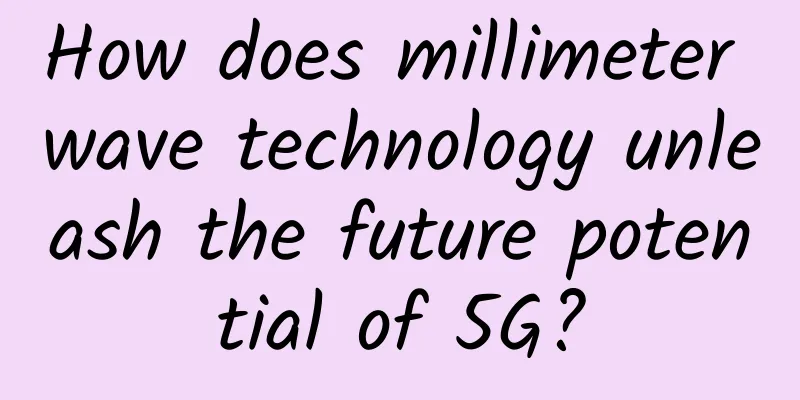How does millimeter wave technology unleash the future potential of 5G?

|
Currently, the major 5G development countries in the world have adopted different frequency bands that meet actual needs to deploy their own 5G commercial networks. According to the differences in frequency bands, they can be divided into two major technical schools: the frequency band from 3GHz to 4GHz, and the frequency band from 20-300GHz. The former is the FR1 band, which is also known as the sub-6GHz band (sub-6GHz). The latter is the main feature of this article: the FR2 band, also called the millimeter wave (mmWave) band (hereinafter referred to as "millimeter wave").
The reason why the millimeter wave band has attracted attention in the 5G era is that in the development of mobile networks before 4G LTE, the radio spectrum of the mainstream bands has been almost completely divided up, and there are not many better bands left for the 5G network that is about to explode and has higher transmission requirements: if we use houses as an analogy, the houses in popular areas and urban areas are almost sold out. This obviously cannot meet the greatly improved usage requirements of the 5G environment, both for transmission and high concurrency. On the other hand, there is another simpler reason why 5G networks are starting to use millimeter wave frequency bands: millimeter waves have a larger available bandwidth and can meet 5G's needs for large capacity and high-speed transmission. Compared with frequency bands below 6GHz, millimeter waves have a shorter transmission delay, which is less than one-fifth of 6GHz; this advantage is crucial for more future use scenarios of 5G: for example, in L4 autonomous driving, remote surgical consultation, cloud gaming or cloud computing and other application scenarios. After reading this, you may ask: Since millimeter waves have more advantages than sub-6GHz frequency bands and can support more 5G usage scenarios with higher speed and latency requirements, why has millimeter waves not yet been fully rolled out for commercial use? Here we need to briefly introduce the characteristics of millimeter waves. Although they have obvious advantages, they also have disadvantages: Due to the inherent characteristics of millimeter waves, the transmission distance of millimeter waves is short. In conventional usage scenarios, the transmission distance of millimeter waves generally does not exceed 10 meters. If there are complex natural environments such as obstructions, bad weather, or even haze, the actual transmission distance will be further attenuated. This is why the millimeter wave band has not been fully developed and utilized in the past 40 years of mobile communication development. However, everything has two sides: the short propagation distance of millimeter waves has become an advantage of millimeter waves in some special usage scenarios: for example, short-distance transmission can effectively reduce the interference between millimeter wave signals from different sources. The high-gain antenna used by millimeter waves has good directivity, which can further eliminate interference and enhance the security of information transmission. In addition, the high-frequency characteristics of millimeter waves will limit the size of their antennas, which actually has corresponding advantages: inside devices of the same size, manufacturers can add more millimeter-wave antennas during design to compensate for the loss of signal transmission, while also making it possible for more devices that support 5G millimeter waves to be further miniaturized: in the future, we may see more different devices in daily life that support millimeter-wave 5G to obtain ultra-high-speed 5G network support, thereby changing the way we use them.
At present, in the gradual advancement of 5G networks in my country, Sub-6GHz is the main networking method for promoting 5G coverage at the current stage, and technology manufacturers including the three major operators and Qualcomm are promoting the development and commercialization of millimeter wave technology through research and development and experiments, so that 5G networks can meet more future usage scenarios with high data transmission requirements. This can also be seen in the research report "5G Millimeter Wave Opportunities in China" released by GSMA: “It should be noted that while lower frequency bands can support these applications in some cases, the potential of mmWave really comes into play when considering the massive scale of connected devices that should be supported in a given area.” Scenarios where many devices use high-speed networks at the same time: For example, during large-scale events, stadiums must not only accommodate tens of thousands of spectators' mobile phones accessing the network at the same time, but also support 8K and even AR, VR and other forms of high-definition event broadcasting needs. In automated factories with smart machines everywhere, different types of industrial robots are remotely controlled accordingly, and the body is required to respond to requests and instructions to meet real-time changes in production needs. These are all scenarios where millimeter wave 5G technology can meet existing usage needs and even significantly change the face of the industry. In the foreseeable future 5G planning, operators can use low, medium and high frequency bands to coordinate networking: the frequency band below 1GHz is used as the coverage layer, Sub-6GHz is used as the capacity to cover mainstream 5G devices, and millimeter waves are used as hotspots to cover high-capacity needs, thereby building a nationwide wide-coverage, large-capacity 5G network. The most imaginative thing is that millimeter wave 5G technology can bring more changes to smart life and smart industry, helping us truly realize the interconnection of all things. During this process, Qualcomm, as one of the leading manufacturers in the field of millimeter wave technology, has been launching more solutions to address the existing disadvantages of millimeter wave, to improve the reliability and data throughput performance of millimeter wave, and to expand more usage scenarios of millimeter wave. At a recent 5G millimeter wave technology seminar hosted by GSMA, Dr. Luo Tao from Qualcomm also explained Qualcomm's related research and implementation results in the current development of millimeter waves: As of mid-2020, Qualcomm has launched three generations of Snapdragon 5G modems and RF systems that support millimeter waves. At the same time, many mobile phone manufacturers have also launched smartphones that support millimeter wave 5G based on the Snapdragon mobile platform: OnePlus has taken the lead in launching a smartphone that supports millimeter wave 5G and put it on the market; in the future, we will see more and more smart terminals that support millimeter wave 5G entering the global market. In addition, the low latency and high transmission rate characteristics of 5G millimeter waves can also penetrate into more consumer electronics life scenarios: such as cloud gaming or cloud computing. These multi-terminal coordinated interactive services all require the support of 5G low-latency communication characteristics; compared with the frequency band below 6GHz, the measured download speed of 5G millimeter wave terminals is 4 times faster, with an average rate of up to 900Mbps and a peak rate of more than 2Gbps; it can greatly promote 4K/8K video streaming services that are still in the early stages of promotion; finally, the high capacity characteristics of millimeter waves will also help operators provide more unlimited data packages, which is naturally a major benefit for users in the 5G era. In the future, the rapid implementation of millimeter wave technology will allow more users to enjoy the high-speed 5G network experience based on millimeter wave technology, which is also a goal that many manufacturers, including Qualcomm, are still pursuing. Improving the reliability of millimeter wave and further promoting the commercial use of millimeter wave in China requires all participants in the entire industry to jointly formulate relevant technical standards and promote the practical use of related technologies, so that 5G technology can truly play its due value in more fields and realize the future vision of 5G "Internet of Everything". |
<<: The United States has approved 6G trials. Is this a far-sighted move or a desperate attempt?
>>: Misunderstood 5G antennas disguised in layers - I feel bitter but cannot express it
Recommend
Exclusive reveal! How 5G can help secure large-scale events
The wonderful opening ceremony of the 2022 Beijin...
Top 10 technology trends governments should watch in 2021
[[391593]] The pandemic has forced government age...
Baidu Takeaway Zhang Jian: Using software engineering thinking to solve operation and maintenance problems
[51CTO.com original article] On April 14, 2017, W...
Here is everything you want to know about 5G progress and next steps
The progress of 5G has always been a key topic of...
Important factors of data center energy efficiency: latent heat and sensible heat
Talking about the PUE value of data centers has a...
Operators have confirmed: The first generation of 5G mobile phones can only use 4G networks
Recently, the inability of NSA 5G phones to conti...
Common network problem location tools that programmers should master
In the process of daily project operation and mai...
RackNerd adds 5 new data centers in San Jose, Dallas, etc., with 2G memory packages starting at $25 per year
Yesterday I received an email from RackNerd, sayi...
The US court's suspension of the TikTok ban will take effect this Sunday
There was another new change today. The U.S. Dist...
Promoting the comprehensive upgrade of SASE services, the front line of Internet technology is catching up with the era of cloud and network security integration
As digital transformation progresses and cloud-ne...
RAKsmart discount upgrade: Hot-selling servers/site cluster servers/1-10Gbps high-bandwidth servers are half price for the first month
RAKsmart has upgraded its July discount plan. In ...
Making cities smarter! Huawei's smart city nervous system demonstrates stronger capabilities from bottom to top
[51CTO.com original article] On the morning of Au...
How to decide if Wi-Fi 6 is right for you?
There’s a lot of hype surrounding the next Wi-Fi ...
Why are operators collectively canceling “unlimited data” packages?
China Telecom announced that it will stop selling...









